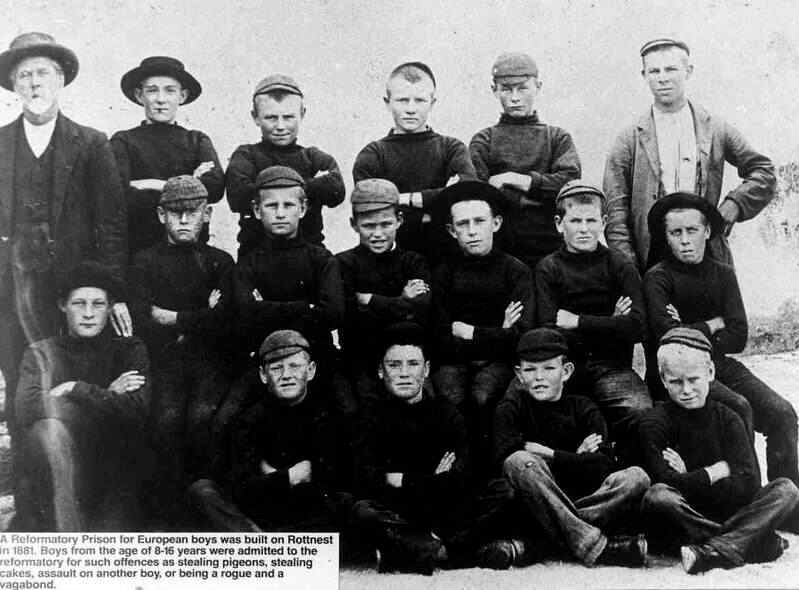
Institutional Clothing for Boys: Reformatories--Australia

Figure 1.--Rottnest Island is located 18 km off Western Australia, near Fremantle. Today it is reserve and a holiday destination. Austrlian authorities began using the island to imprison recalcitrant Aboriginies (1838). Authorities in Western Australia decided to open a boys' reformatory on the island (1881). It was located next to the Aboriginal Prison. Facilities included a workshop, kitchen, dormitories, a school room, and four small cells. Upon completion of the building work. John Watson was a carpenter who oversaw the construction of the buildings. He remained to serve as the Superintendent and also to to teach the boys carpentry, joinery, and gardening. The boys wore a basic uniform as can be seen here. Note the long pants. Boys at the time were commonly wearing knee pants. Authorities closed the buildings after 20 years (1901). Watson's building remain and today are used as holiday accomodations.
|
|
A HBC reader from Queensland, Australia has submitted the following information about Australian reformatories and clothing in the 1950s and 60s. He reports that the images have been digitally altered to protect the privacy of the boys involved. With only a few exceptions, HBC will not use an image if it is known to be digitally altered in any way. In this case we have made an exception.
The Institutions
Distressing reports in recent years have emerged about Australian reformatories. These reports parallel similar reports that have emerged from Australian oprhanages, even orphanages run by religious orders. Australian boys held in reformatories during the post World War II (1939-45) period were often subjected to severe abuse. The main punishments were solitary confinement, the cane, being made to walk a path between posts for long periods of time, and standing at attention while facing a wall, or kneeling. They were also subject to severe assaults, bullying, and other forms of flagereant abuse from older boys and staff.
Uniforns
Uniforms at the time were typical of state institutions. Long-sleeved cotton drill shirts
with closed-fronts and double-breasted pockets reflected the military style after
World War II. This style used less fabric to make, and Government stores had tons of them.
They lasted well until the mid-1960s, although by then the rest of the community
had adopted the "American Coat Style" shirts, the term used to describe open-fronted shirts (which were a novelty to Australians in the 1950s).
Admission
Boys could be admitted to State reformatories for "Status" offences such
as "being in need of care", Uncontrollable", etc. In many instances, unwanted boys could
be brought before the courts as "uncontrollable" by their parents. This
meant that many children were incarcerated without having committed
any criminal offences. Some boys from this period spent most of their lives incarcerated because they became "Institutionally Dependent" - unable to live a normal life in the outside community. One 55-year old man had had only 7 weeks of his life outside of penal
care since the age of 8 years. Many boys were as young as 8 or 9 years of age.
Conditions
Dormitories were crowded and boys were subjected to bullying, assaults, and sexual
abuse from older boys and sometimes staff. Meals were of indifferent quality and boys
had to eat food that was often unacceptable. Monitoring of institutions was done
poorly, and unsatisfactory conditions continued for years until government
inquiries during the 1970s revealed serious deficiencies.
Release
Many boys were released into a community without education or training. Unable to cope, they often reverted to lives of crime. Many, scarred by their abused childhoods became vicious criminals. About 75 percebnt of inmates were aboriginal or part aboriginal, despite being less than 2 percent of the general population. Many aboriginal boys were far from their homes, living in a foreign culture with very different rules from their own. Often they were incarcerated at the whim of their reservation managers without trial or due
process. Many tragically died in custody, some ended their own lives, choosing to die rather than endure the terrible conditions in the reformatories.
Sources
The above information was gleaned from official government reports produced after inquiries during the 1980s. As a result of these reports, many institutions were closed and reform introduced. Photos came from a former staffer. They were taken at an unidentified facility. The boys’ faces have been digitally altered to protect
their identities.
Current Conditions
The state of Queensland now has a Childrens’ Commission with special powers to investigate child abuse. Incarceration of juveniles occurs only as a last resort. Institutions are modern and run to high standards. Staff must be trained and vetted before being employed. Security procedures such as Independent monitoring via security cameras and random inspections are features of child protection measures that are now taken.
Geoff
HBC

Navigate the Historic Boys' Clothing Web Site:
[Return to the Main refprmatory page]
[Introduction]
[Activities]
[Biographies]
[Chronology]
[Cloth and textiles]
[Clothing styles]
[Countries]
[Topics]
[Bibliographies]
[Contributions]
[FAQs]
[Glossaries]
[Images]
[Links]
[Registration]
[Tools]
[Boys' Clothing Home]
Created: July 22, 2001
Last update: 7:29 PM 1/7/2009



